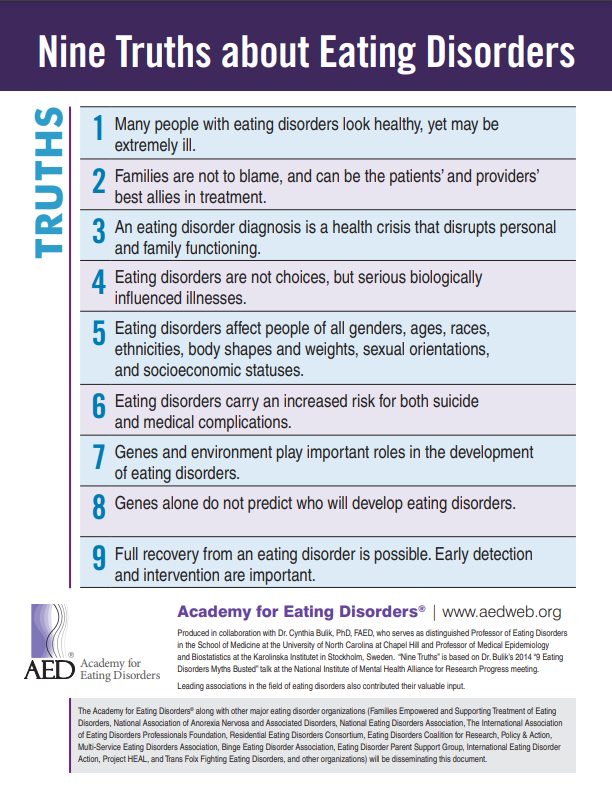
Eating disorders are complex mental illnesses with physical manifestations. A variety of factors contribute to the development of an eating disorder, which can be organized into three broad categories:
This is called the biopsychosocial model. This model is useful for understanding how and why eating disorders develop as it considers the connection between mind, body, and the environment.
While eating disorders are serious and can have life-threatening complications, they are also treatable illnesses. You can search for support and treatment providers in our Service Provider Directory.

Many factors can influence the development of an eating disorder. These factors can be biological, psychological, and sociocultural. For individuals with a genetic or biological vulnerability, exposure to certain social or cultural conditions, such as pressures to eat or look a certain way, can trigger symptoms. Individuals who are struggling with their identity and self-image can be at risk, as can those who have experienced trauma.
Because eating disorders and mental illness are still stigmatized, some people who have disordered eating may be secretive or ashamed and go to great lengths to hide their disorder.
If the way you eat and think about food interferes with your life and keeps you from enjoying life and moving forward, you may be experiencing disordered eating. Take it seriously and talk to someone who can help. You don’t need to wait for a diagnosis by a doctor.


The experience of living with an eating disorder can be different for each affected individual. Some people feel shame stemming from their symptoms or the way they eat, and so are secretive about food and eating. Some people experience other mental illnesses, such as anxiety, depression, obsessive-compulsive disorder, or post-traumatic stress disorder together with their eating disorder.
Eating disorders are as diverse as the people they affect.
Findings from the last Canadian Community Health Survey – Mental Health indicate that in 2012, over 113 000 individuals ages 15 and older were living with an eating disorder diagnosed by a health professional.
Statistics Canada. (n.d.). Table 13-10-0465-01 Mental health
indicators. https://doi.org/10.25318/1310046501-eng
International research indicates that the point prevalence of eating disorders ranges from 2.2% to 4.6%.
Galmiche, M., Déchelotte, P., Lambert, G., & Tavolacci, M. P. (2019). Prevalence of eating disorders over the 2000–2018 period: A systematic literature review. The American Journal of Clinical Nutrition, 109(5), 1402–1413.
https://doi.org/10.1093/ajcn/nqy342
Based on prevalence data from international research, at any given time, an estimated 908,000 to 1,900,000 people in Canada have symptoms sufficient for an eating disorder diagnosis.
View PDFFacts and StatisticsChildren learn (unhealthy) mainstream attitudes towards food and weight at a very young age. In a study of five-year-old girls, a significant proportion of girls associated a diet with food restriction, weight-loss and thinness.
Abramovitz, B. A. & Birch, L. L. (2000). Five-year-old girls’ ideas about dieting are predicted by their mothers’ dieting. Journal of the American Dietetic Association, 100 (10), 1157-1163.
Fifty-eight percent of grade 9 and 10 girls are trying to lose weight, including 50% of of those who are “normal” weight and almost 90% of those classified as “obese” based on BMI.
Raffoul, A., Leatherdale, S. T., & Kirkpatrick, S. I. (2018). Dieting predicts engagement in multiple risky behaviours among adolescent Canadian girls: A longitudinal analysis. Canadian Journal of Public Health, 109(1), 61-69.
In a Canadian survey of youth ages 12 to 24 that was administered in both clinical and non-clinical service sectors, 23 to 25% reported disordered eating symptoms like binge eating and weight control behaviours.
Henderson, J. L., Chaim, G., Hawke, L. D., & National Youth Screening Project Network. (2017). Screening for substance use and mental health problems in a cross-sectoral sample of Canadian youth. International Journal of Mental Health Systems, 11, 21. https://doi.org/10.1186/s13033-017-0128-4
In a survey of adolescents in grades 7–12, 30% of girls and 25% of boys reported teasing by peers about their weight. Such teasing has been found to persist in the home as well – 29% of girls and 16% of boys reported having been teased by a family member about their weight.
Eisenberg, M. E. & Neumark-Sztainer, D. (2003). Associations of weight-based teasing and emotional well-being among adolescents. Archives of Pediatrics & Adolescent Medicine, 157(6), 733-738.
Body-based teasing can have a serious impact on girls’ attitudes and behaviours. According to one study, girls who reported teasing by family members were 1.5 times more likely to engage in binge-eating and extreme weight control behaviours five years later.
Neumark-Sztainer, D. R., Wall, M. M., Haines, J. I., Story, M. T., Sherwood, N. E., van den Berg, P. A. (2007). Shared risk and protective factors for overweight and disordered eating in adolescents. American Journal of Preventative Medicine, 33(5), 359-369.
"Overweight" and "obese" children (based on BMI) are more likely to be bullied than their "normal" weight peers. For example:
- In a survey of 11–16 year-olds, 10% of "normal"-weight children reported being bullied, compared to 15% of "overweight" and 23% of "obese" children
- "Obese" girls were 2.7 times more likely than "normal"-weight girls to be verbally bullied on a regular basis and 3.4 times more likely to be excluded from group activities
Janssen, I., Craig, W. M., Boyce, W. F. & Pickett, W. (2004). Associations between overweight and obesity with bullying behaviours in school-age children. Pediatrics, 113(5), 1187-1194.
In a study of 14–15 year old adolescents, girls who engaged in strict dieting practices:
- Were 18 times more likely to develop an eating disorder within six months than non-dieters
- Had almost a 20% chance of developing an eating disorder within one year
Girls who dieted moderately were five times more likely to develop an ED within six months than non-dieters.
Patton, G. C., Selzer, R., Coffey, C., Carlin, J. B. & Wolfe, R. (1999). Onset of adolescent eating disorders: population based cohort study over 3 years. British Medical Journal, 318, 765-768.
2.2% boys and 4.5% of girls in a large sample of Ontario adolescents met DSM-5 criteria for an ED.
Flament, M. F., Henderson, K., Buchholz, A., Obeid, N., Nguyen, H. N. T., Birmingham, M., & Goldfield, G. (2015). Weight status and DSM-5 diagnoses of eating disorders in adolescents from the community. Journal of the American Academy of Child & Adolescent Psychiatry, 54(5), 403–413. https://doi.org/10.1016/j.jaac.2015.01.020
View PDFIn a 2021 survey of youth ages 16 to 30 across Canada, nearly half (48.9%) of the young men who participated indicated that they engaged within the past year in "bulking and cutting" to control their body weight, shape, and composition.
Ganson, K. T., Cunningham, M. L., Pila, E., Rodgers, R. F., Murray, S. B., & Nagata, J. M. (2022).
Eating and Weight Disorders. "Bulking and cutting” among a national sample of Canadian adolescents and young adults. Eating and Weight Disorders, 27, 3759–3765. https://doi.org/10.1007/s40519-022-01470-y
Among the post-secondary students in Canada who participated in the Spring 2022 National College Health Assessment survey and identified as a cis man, 3% reported that their academic performance had been negatively affected to an ED or disordered eating that they had experienced in the past year.
American College Health Association. (2022). American College Health Association-National College Health Assessment III: Canadian Reference Group Data Report Spring 2022. Silver Spring, MD: American College Health Association. https://www.acha.org/wp-content/uploads/2024/07/NCHA-III_SPRING_2022_CANADIAN_REFERENCE_GROUP_DATA_REPORT.pdf
View PDFView WebinarAccording to a Norwegian study, elite athletes demonstrate significantly higher rates of eating disorders compared to population controls. In one study, 20% of elite female athletes met the criteria for having an eating disorder, compared to 9% of female controls. In men, 8% of elite male athletes met the criteria for having an eating disorder, compared to 0.5% of male controls.
Sungot-Borgen, J. & Torstveit, M.K. (2004). Prevalence of eating disorders in elite athletes is higher than in the general population. Clinical Journal of Sport Medicine, 14(1), 25-32.
Athletes in sports with an aesthetic component or weight categories are especially likely to engage in eating disorder behaviours.
Giel, K. E., Hermann-Werner, A., Mayer, J., Diehl, K., Schneider, S., Thiel, A., Zipfel, S., & GOAL Study Group. (2016). Eating disorder pathology in elite adolescent athletes. International Journal of Eating Disorders, 49(6), 553–562. https://doi.org/10.1002/eat.22511
Walter, N., Heinen, T., & Elbe, A.-M. (2022). Factors associated with disordered eating and eating disorder symptoms in adolescent elite athletes. Sports Psychiatry, 1(2), 47–56. https://doi.org/10.1024/2674-0052/a00001
In a survey of 1001 Canadian national team athletes, 16% of current athletes and 28% of retired athletes reported engaging in eating disorder behaviours.
Kerr, G., Willson, E., &Stirling, A. (2019). Prevalence of Maltreatment Among Current and Former National Team Athletes. https://athletescan.ca/wp-content/uploads/2014/03/prevalence_of_maltreatment_reporteng.pdf
View WebinarTo clarify public understanding, the Academy for Eating Disorders, in collaboration with Dr. Cynthia Bulik, PhD, FAED, Professor at the University of North Carolina at Chapel Hill, produced “Nine Truths About Eating Disorders”. This document is based on a talk that Dr. Bulik delivered in 2014 entitled “9 Eating Disorders Myths Busted”.
